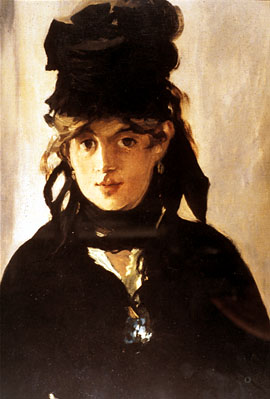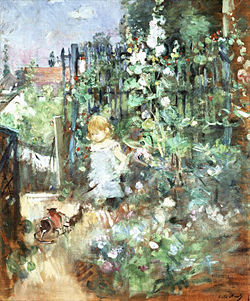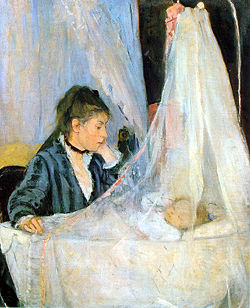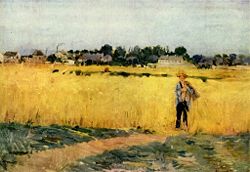Difference between revisions of "Berthe Morisot" - New World Encyclopedia
m (→References) |
|||
| Line 22: | Line 22: | ||
Morisot's first appearance in the [[Paris Salon|Salon de Paris]] came at the age of twenty-three in 1864, with the acceptance of two [[landscape]] paintings. She continued to show regularly in the Salon, to generally favorable reviews, until 1873, the year before the first Impressionist exhibition. | Morisot's first appearance in the [[Paris Salon|Salon de Paris]] came at the age of twenty-three in 1864, with the acceptance of two [[landscape]] paintings. She continued to show regularly in the Salon, to generally favorable reviews, until 1873, the year before the first Impressionist exhibition. | ||
| − | + | ||
Meanwhile, in 1868 Morisot became acquainted with [[Édouard Manet]]. He took a special interest in Morisot, as is evident from his warm portrayal of her in several paintings, including a striking portrait study of Morisot in a black veil, while in mourning for her father's death. It is displayed at the top of the article. Correspondence between them bespeaks affection. He once gave her an [[easel]] as a [[Christmas]] [[Gift|present]]. He also interfered in one of her Salon submissions when he was engaged to transport it. Manet mistook one of Morisot's self-criticisms as an invitation to add his corrections, which he did, much to Morisot's dismay. | Meanwhile, in 1868 Morisot became acquainted with [[Édouard Manet]]. He took a special interest in Morisot, as is evident from his warm portrayal of her in several paintings, including a striking portrait study of Morisot in a black veil, while in mourning for her father's death. It is displayed at the top of the article. Correspondence between them bespeaks affection. He once gave her an [[easel]] as a [[Christmas]] [[Gift|present]]. He also interfered in one of her Salon submissions when he was engaged to transport it. Manet mistook one of Morisot's self-criticisms as an invitation to add his corrections, which he did, much to Morisot's dismay. | ||
| − | Although traditionally Manet has been related as the master and Morisot as the follower, there is evidence that their relationship was a reciprocating one.<ref>Turner, 2000, p. 319.</ref> Morisot had developed her own distinctive artistic style. Records of paintings show Manet's approval and appreciation of certain stylistic and compositional decisions that Morisot originated. He incorporated some of these characteristics into his own work. | + | Although traditionally Manet has been related as the master and Morisot as the follower, there is evidence that their relationship was a reciprocating one.<ref>Turner, 2000, p. 319.</ref> Morisot had developed her own distinctive artistic style. Records of paintings show Manet's approval and appreciation of certain stylistic and compositional decisions that Morisot originated. He incorporated some of these characteristics into his own work. She encouraged him to adopt the impressionistic "high-keyed palate" and to abandon the use of black and grays. Her own compositions used bright-hued colors, free of the grays and blacks of contemporary painters. |
| − | [[Image: | + | [[Image:BMorisot.JPG|thumbnail|190px|''L'Enfant au Tablier Rouge'', a sketch by Berthe Morisot]] |
| + | It was Morisot who convinced Manet to attempt [[plein air]] painting,{{Fact|date=February 2007}} which she had been practicing since having been introduced to it by Corot. | ||
She also drew Manet into the circle of painters who soon became known as the Impressionists. In 1874, Morisot married Manet's brother, Eugene, and they had one daughter, Julie. | She also drew Manet into the circle of painters who soon became known as the Impressionists. In 1874, Morisot married Manet's brother, Eugene, and they had one daughter, Julie. | ||
| Line 37: | Line 38: | ||
==Morisot's Paintings== | ==Morisot's Paintings== | ||
Her work includes: | Her work includes: | ||
| − | * [Un Village,(Study: At the Water's Edge), 1864] | + | * [[Un Village,(Study: At the Water's Edge), 1864]] |
| − | * [Portrait of Edma Pontillion, the artist's sister at a window, (Young Woman Seated at a Window), 1869] | + | * [[Portrait of Edma Pontillion, the artist's sister at a window, (Young Woman Seated at a Window), 1869]] |
| − | * [Marine, 1869] | + | * [[Marine, 1869]] |
| − | * [La Lecture, 1869-70] | + | [[Image:Berthe Morisot Kind zwischen Stockrosen.jpg|thumb|250px| ''Child among staked roses'', by Berthe Morrisot, 1881, [[Wallraf-Richartz Museum]][[Cologne]]]] |
| − | * [On the Balcony, 1871-1872] | + | * [[La Lecture, 1869-70]] |
| − | * [Le Berceau (cradle), 1872] | + | * [[On the Balcony, 1871-1872]] |
| − | * [Cashe-cashe (Hide and Seek), 1873] | + | * [[Le Berceau (cradle), 1872]] |
| − | * [Portrait de Mademoiselle MT, (Young girl with a Parrot), 1873] | + | * [[Cashe-cashe (Hide and Seek), 1873]] |
| − | * [Butterfly Hunt, 1874] | + | * [[Portrait de Mademoiselle MT, (Young girl with a Parrot), 1873]] |
| − | * [In a Park, (On the Grass), 1974] | + | * [[Butterfly Hunt, 1874]] |
| − | * [Eugéne Manet on the Isle of Wight, 1875] | + | * [[In a Park, (On the Grass), 1974]] |
| − | * [Figure of a woman, 1875-76] | + | * [[Eugéne Manet on the Isle of Wight, 1875]] |
| − | * [The Pscyhé, (The Cheval Glass), 1876] | + | * [[Figure of a woman, 1875-76]] |
| − | * [Portrait of Marcel Gobillard, (Little Boy in Gray), 1880] | + | * [[The Pscyhé, (The Cheval Glass), 1876]] |
| − | * [Peasant Hanging out the Washing, 1881] | + | * [[Portrait of Marcel Gobillard, (Little Boy in Gray), 1880]] |
| − | * [Little Girl with a Doll, 1884] | + | * [[Peasant Hanging out the Washing, 1881]] |
| − | * [The Bath, (Girl Arranging Her Hair), 1885-86] | + | * [[Little Girl with a Doll, 1884]] |
| − | * [Little Girl Reading, 1888] | + | * [[The Bath, (Girl Arranging Her Hair), 1885-86]] |
| − | * [Juliet Manet et son Levrier Laerte, 1893] | + | * [[Little Girl Reading, 1888]] |
| − | * [Juliet Reveuse, (Julie Daydreaming), 1894, the model is her daughter] | + | * [[Juliet Manet et son Levrier Laerte, 1893]] |
| + | * [[Juliet Reveuse, (Julie Daydreaming), 1894, the model is her daughter]] | ||
Berthe Morisot died aged 54, on March 2, 1895 in [[Paris]] and was interred in the [[Cimetière de Passy]]. | Berthe Morisot died aged 54, on March 2, 1895 in [[Paris]] and was interred in the [[Cimetière de Passy]]. | ||
| Line 71: | Line 73: | ||
*Denvir, B. (2000). ''The Chronicle of Impressionism: An Intimate DIary of the Lives and World of the Great Artists''. London: Thames & Hudson. OCLC 43339405 | *Denvir, B. (2000). ''The Chronicle of Impressionism: An Intimate DIary of the Lives and World of the Great Artists''. London: Thames & Hudson. OCLC 43339405 | ||
*Turner, J. (2000). ''From Monet to Cézanne: late 19th-century French artists''. Grove Art. New York: St Martin's Press. ISBN 0-312-22971-2 | *Turner, J. (2000). ''From Monet to Cézanne: late 19th-century French artists''. Grove Art. New York: St Martin's Press. ISBN 0-312-22971-2 | ||
| + | * Adler, Kathleen, ''Berthe Morisot''. Phaidon Press; Reprint edition, 1995. ISBN 978-0714834795 | ||
| + | * Higonnet, Anne, ''Berthe Morisot''. University of California Press; New Ed edition, 1995. ISBN 978-0520201569 | ||
== External links == | == External links == | ||
Revision as of 20:24, 7 April 2007

Berthe Morisot (January 14, 1841 – March 2, 1895) was a painter and a printmaker, and the first woman member of the circle of painters in Paris who became known as the Impressionists. She and American-born Mary Cassatt were the most famous women impressionist painters. They are considered by many to be the most important women painters of the later nineteenth century.
In 1864, she exhibited for the first time in the highly esteemed Salon de Paris. Sponsored by the government, and judged by academicians, the Salon was the official, annual exhibition of the Académie des beaux-arts in Paris. Her work was selected for exhibition in six subsequent Salons[1] until, in 1874, she joined the "rejected" Impressionists in the first of their own exhibitions, which was founded by Cézanne, Degas, Monet, Morisot, Pissarro, Renoir, and Sisley. It was held at the studio of the photographer, Nadar, (Gaspard-Félix Tournachon). It was from this "alternative" showing of art that criticism caused the style to be called mere "impressionism" by journalist Louis Leroy writing in the satirical magazine Le Charivari in 1874. This ultimately led to the entire movement being called "Impressionist." The artists themselves embraced this title as it described their desire to convey the visual impressions of how light played on objects and color.
She was the granddaughter of the Rococo painter, Jean-Honoré Fragonard. She dedicated herself to painting at an early age and exhibited a seriousness that many women at the time were not able to achieve. From 1862 to 1868 she worked under her mentor Camille Corot. She regularly exhibited her work at the Salon from 1864 to 1874. But after that time she vowed never to show her work there again as the official artistic community began to criticize the newly emerging style of painting of the Impressionists. In 1968 she met Édouard Manet who influenced her work greatly, his style (emphasizing the use of color, texture and hue, and minimizing the traditional subject matter), liberated hers and she in return stimulated his interest in "plein air" painting, or painting completely in the outdoors.
She showed painting in six of the seven subsequent independent shows, the last in 1886. She produced twenty notable paintings:
Education
Morisot was born in Bourges, Cher, France into a successful bourgeois family. Both she and her sister Edma Morisot chose to become painters. Once Berthe Morisot settled on pursuing art, her family did not impede her career.
She was born into a family that had included one of the most prolific Rococo painters of the ancien régime, Fragonard, whose handling of colour and expressive, confident brushwork influenced later painters. By age twenty, she had met and befriended the important, and pivotal, landscape painter of the Barbizon School, who excelled in figure painting as well, Camille Corot.
The older artist instructed Berthe and her sister in painting and introduced them to other artists and teachers. Under Corot's influence, Morisot took up the plein air method of working. As art students, Berthe and Edma worked closely together until Edma married, had children, and no longer had time to paint so intensely as Berthe. Letters between them show a loving and cordial relationship, underscored by Berthe's regret at the distance between them and about Edma's withdrawal from painting. Edma wholeheartedly supported Berthe's continued work and the families of the two sisters always remained close.
Manet and impressionism
Morisot's first appearance in the Salon de Paris came at the age of twenty-three in 1864, with the acceptance of two landscape paintings. She continued to show regularly in the Salon, to generally favorable reviews, until 1873, the year before the first Impressionist exhibition.
Meanwhile, in 1868 Morisot became acquainted with Édouard Manet. He took a special interest in Morisot, as is evident from his warm portrayal of her in several paintings, including a striking portrait study of Morisot in a black veil, while in mourning for her father's death. It is displayed at the top of the article. Correspondence between them bespeaks affection. He once gave her an easel as a Christmas present. He also interfered in one of her Salon submissions when he was engaged to transport it. Manet mistook one of Morisot's self-criticisms as an invitation to add his corrections, which he did, much to Morisot's dismay.
Although traditionally Manet has been related as the master and Morisot as the follower, there is evidence that their relationship was a reciprocating one.[2] Morisot had developed her own distinctive artistic style. Records of paintings show Manet's approval and appreciation of certain stylistic and compositional decisions that Morisot originated. He incorporated some of these characteristics into his own work. She encouraged him to adopt the impressionistic "high-keyed palate" and to abandon the use of black and grays. Her own compositions used bright-hued colors, free of the grays and blacks of contemporary painters.
It was Morisot who convinced Manet to attempt plein air painting,[citation needed] which she had been practicing since having been introduced to it by Corot.
She also drew Manet into the circle of painters who soon became known as the Impressionists. In 1874, Morisot married Manet's brother, Eugene, and they had one daughter, Julie.
As a doctrinaire Impressionist as well as a member of the haute bourgeoisie, Morisot painted what she experienced on a daily basis. Her paintings reflect the 19th century cultural restrictions of her class and gender. She avoided urban and street scenes as well as the nude figure and, like her fellow female Impressionist Mary Cassatt, focused on domestic life and portraits in which she could use family and personal friends as models. Paintings like The Cradle, 1872 in which she depicted current trends for nursery furniture reflect her sensitivity to fashion and advertising, both of which would have been apparent to her female audience.
Her works include not only landscapes, portraits, garden settings, and boating scenes, but also subjects portraying the comfort and intimacy of family and domestic life, as did her colleagues, Pierre-Auguste Renoir and Mary Cassatt.
Morisot's Paintings
Her work includes:
- Un Village,(Study: At the Water's Edge), 1864
- Portrait of Edma Pontillion, the artist's sister at a window, (Young Woman Seated at a Window), 1869
- Marine, 1869

- La Lecture, 1869-70
- On the Balcony, 1871-1872
- Le Berceau (cradle), 1872
- Cashe-cashe (Hide and Seek), 1873
- Portrait de Mademoiselle MT, (Young girl with a Parrot), 1873
- Butterfly Hunt, 1874
- In a Park, (On the Grass), 1974
- Eugéne Manet on the Isle of Wight, 1875
- Figure of a woman, 1875-76
- The Pscyhé, (The Cheval Glass), 1876
- Portrait of Marcel Gobillard, (Little Boy in Gray), 1880
- Peasant Hanging out the Washing, 1881
- Little Girl with a Doll, 1884
- The Bath, (Girl Arranging Her Hair), 1885-86
- Little Girl Reading, 1888
- Juliet Manet et son Levrier Laerte, 1893
- Juliet Reveuse, (Julie Daydreaming), 1894, the model is her daughter
Berthe Morisot died aged 54, on March 2, 1895 in Paris and was interred in the Cimetière de Passy.
See also
- Women artists
Notes
ReferencesISBN links support NWE through referral fees
- Denvir, B. (2000). The Chronicle of Impressionism: An Intimate DIary of the Lives and World of the Great Artists. London: Thames & Hudson. OCLC 43339405
- Turner, J. (2000). From Monet to Cézanne: late 19th-century French artists. Grove Art. New York: St Martin's Press. ISBN 0-312-22971-2
- Adler, Kathleen, Berthe Morisot. Phaidon Press; Reprint edition, 1995. ISBN 978-0714834795
- Higonnet, Anne, Berthe Morisot. University of California Press; New Ed edition, 1995. ISBN 978-0520201569
External links
- Berthe Morisot at the WebMuseum
Credits
New World Encyclopedia writers and editors rewrote and completed the Wikipedia article in accordance with New World Encyclopedia standards. This article abides by terms of the Creative Commons CC-by-sa 3.0 License (CC-by-sa), which may be used and disseminated with proper attribution. Credit is due under the terms of this license that can reference both the New World Encyclopedia contributors and the selfless volunteer contributors of the Wikimedia Foundation. To cite this article click here for a list of acceptable citing formats.The history of earlier contributions by wikipedians is accessible to researchers here:
The history of this article since it was imported to New World Encyclopedia:
Note: Some restrictions may apply to use of individual images which are separately licensed.


